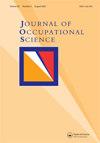Occupations, social connections, health, and well-being of US university students during COVID-19
IF 2.4
Q1 SOCIAL SCIENCES, INTERDISCIPLINARY
引用次数: 2
Abstract
ABSTRACT Objective: Participation in social occupations and some daily occupations decreased significantly due to social distancing and lockdown measures during COVID-19 pandemic. Little is known about how social occupations and connections impact the way people adapt to support their health and well-being. The aim of this study was to further discern the relationship between adaptation to occupational disruption, participation in social occupations, and health and well-being during the global pandemic. Method: Twenty-two university students completed in-depth interviews via video conferencing as part of a larger descriptive research design with multiple methods of data collection. In the interviews, students described their responses to social distancing measures and how they adapted their social occupations and social connections within their day-to-day occupations over several months. Results: Qualitative analysis, using constant comparative method, revealed three themes. First, changes in the nature of doing social occupations. Second, the impact on participation in all other occupations. And third, how these adapted occupations impacted perceived health and well-being. Portraits of three participants elucidate the complex interactions of factors within an individual’s life that influence occupational choices and adaptations. Conclusion: Students’ experiences in adapting and sustaining their social connections within the pandemic context reflect the non-linear fluid relationship between doing, being, becoming, and belonging and how life is improvised with occupational disruption. This dynamic relationship begins to identify some of the complexity between occupation, health, and well-being.COVID-19期间美国大学生的职业、社会关系、健康和福祉
【摘要】目的:新冠肺炎大流行期间,由于社会隔离和封锁措施,社会职业和部分日常职业的参与率明显下降。关于社会职业和社会关系如何影响人们适应以维持健康和幸福的方式,我们知之甚少。本研究的目的是进一步辨别在全球大流行期间适应职业中断、参与社会职业以及健康和福祉之间的关系。方法:22名大学生通过视频会议完成深度访谈,这是一个更大的描述性研究设计的一部分,采用多种数据收集方法。在访谈中,学生们描述了他们对社会距离措施的反应,以及他们在几个月的日常工作中如何适应他们的社会职业和社会联系。结果:定性分析采用恒定比较法,揭示了三个主题。第一,从事社会职业性质的变化。第二,对所有其他职业参与率的影响。第三,这些适应性职业如何影响感知健康和幸福。三位参与者的肖像阐明了个人生活中影响职业选择和适应的因素之间复杂的相互作用。结论:学生在大流行背景下适应和维持社会关系的经历反映了行为、存在、成为和归属之间的非线性流动关系,以及生活如何随职业中断而临时改变。这种动态关系开始确定职业、健康和幸福之间的一些复杂性。
本文章由计算机程序翻译,如有差异,请以英文原文为准。
求助全文
约1分钟内获得全文
求助全文
来源期刊

Journal of Occupational Science
SOCIAL SCIENCES, INTERDISCIPLINARY-
CiteScore
4.30
自引率
41.70%
发文量
46
 求助内容:
求助内容: 应助结果提醒方式:
应助结果提醒方式:


